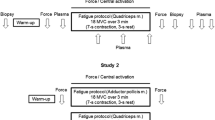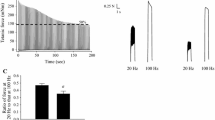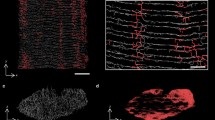Abstract
Mechanisms of fatigue were studied in single muscle fibres of the cane toad (Bufo marinus) in which force, intracellular calcium ([Ca2+]i), [Mg2+]i, glycogen and the rapidly releasable Ca2+ from the sarcoplasmic reticulum (SR) were measured. Fatigue was produced by repeated tetani continued until force had fallen to 50%. Two patterns of fatigue in the absence of glucose were studied. In the first fatigue run force fell to 50% in 8–10 min. Fatigue runs were then repeated until force fell to 50% in <3 min in the final fatigue run. Addition of extracellular glucose after the final fatigue run prolonged a subsequent fatigue run. In the first fatigue run peak tetanic [Ca2+]i initially increased and then declined and at the time when force had fallen to 50% tetanic [Ca2+]i was 54 ± 5% of initial value. In the final fatigue run force and peak tetanic [Ca2+]i declined more rapidly but to the same level as in first fatigue runs. At the end of the first fatigue run, the rapidly releasable SR Ca2+ store fell to 46 ± 6% of the pre-fatigue value. At the end of the final fatigue run the rapidly releasable SR Ca2+ store was 109 ± 16% of the pre-fatigue value. In unstimulated fibres the nonwashable glycogen content was 176 ± 30 mmol glycosyl units/l fibre. After one fatigue run the glycogen content was 117 ± 17 mmol glycosyl units/l fibre; at the end of the final fatigue run the glycogen content was reduced to 85 ± 9 mmol glycosyl units/l fibre. [Mg2+]i did not change significantly at the end of fatigue in either the first or the final fatigue run suggesting that globally-averaged ATP does not decline substantially in either pattern of fatigue. These results suggest that different mechanisms are involved in the decline of tetanic [Ca2+]i in first compared to final fatigue runs. The SR Ca2+ store is reduced in first fatigue runs; this is not the case for the final fatigue run which is associated with a decline in glycogen and possibly related to either a non-metabolic effect of glycogen or a spatially-localised metabolic decline.
Similar content being viewed by others
References
Allen DG, Lännergren J and Westerblad H (1995) Muscle cell function during prolonged activity: cellular mechanisms of fatigue. Exp Physiol 80: 497–527.
Andrade FH, Reid MB, Allen DG and Westerblad H (1998) Effect of hydrogen peroxide and dithiothreitol on contractile function of single skeletal muscle fibres from the mouse. J Physiol 509: 565–575.
Bakker AJ, Head SI, Williams DA and Stephenson DG (1993) Ca2+ levels in myotubes grown from the skeletal muscle of dystrophic (mdx) and normal mice. J Physiol 460: 1–13.
Bergströ m J, Hermansen L, Hultman E and Saltin B (1967) Diet, muscle glycogen and physical performance. Acta Physiol Scand 71: 140–150.
Chin ER and Allen DG (1997) Effects of reduced muscle glycogen concentration on force, Ca2+ release and contractile protein function in intact mouse skeletal muscle. J Physiol 498: 17–29.
Dean RB and Dixon WJ (1951) Simplified statistics for small numbers of observations. Anal Chem 23: 636–638.
Eberstein A and Sandow A (1963) Fatigue mechanisms in muscle fibers. In:Gutman E and Hink P (eds) The effect of use and disuse on the neuromuscular functions, (pp. 515–526) Elsevier, Amsterdam.
Entman ML, Keslensky SS, Chu A and Van Winkle WB (1980) The sarcoplasmic reticulum-glycogenolytic complex in mammalian fast twitch skeletal muscle. J Biol Chem 255: 6245–6252.
Favero TG (1999) Sarcoplasmic reticulum Ca2+ release and muscle fatigue. J App Physiol 87: 471–483.
Fridén J, Seger J and Ekblom B (1989) Topographical localization of muscle glycogen: an ultrahistochemical study in the human vastus lateralis. Acta Physiol Scand 135: 381–391.
Fryer MW, Owen VJ, Lamb GD and Stephenson DG (1995) Effects of creatine phosphate and P i on Ca2+ movements and tension development in rat skinned skeletal muscle fibres. J Physiol 482: 123–140.
Green HJ (1990) How important is endogenous glycogen to fatigue in prolonged exercise? Can J Physiol Pharmacol 69: 290–297.
Grynkiewicz G, Poenie M and Tsien RY (1985) A new generation of Ca2+ indicators with greatly improved fluorescence properties. J Biol Chem 260: 3440–3450.
Han J-W, Thieleczek R, Varsanyi M and Heilmeyer LMG (1992) Compartmentalized ATP synthesis in skeletal muscle triads. Biochem 31: 377–384.
Hermansen L, Hultman E and Saltin B (1967) Muscle glycogen during prolonged severe exercise. Acta Physiol Scand 71: 129–139.
Kabbara AA and Allen DG (1999a) Measurement of sarcoplasmic reticulum Ca2+ content in intact amphibian skeletal muscle fibres with 4-chloro-m-cresol. Cell Calcium 25: 227–235.
Kabbara AA and Allen DG (1999b) The role of calcium stores in fatigue of isolated single muscle fibres from the cane toad. J Physiol 519: 169–176.
Millar NC and Homsher E (1990) The effect of phosphate and calcium on force generation in glycerinated rabbit skeletal muscle fibers; a steady-state and transient kinetic study. J Biol Chem 265: 20,234–20,240.
Nguyen LT, Stephenson DG and Stephenson GMM (1998a) A direct microfluorimetric method for measuring subpicomol amounts of NADPH, glucose and glycogen. Anal Biochem 259: 274–278.
Nguyen LT, Stephenson DG and Stephenson GMM (1998b) Micro-fluorometric analyses of glycogen in freshly dissected, single skeletal muscle fibres of the cane toad using a mechanically skinned fibre preparation. J Muscle Res Cell Motil 19: 631–638.
Posterino GS and Fryer MW (1998) Mechanisms underlying phos-phate-induced failure of Ca2+ release in single skinned skeletal muscle fibres of the rat. J Physiol 512: 97–108.
Smith JS, Coronado R and Meissner G (1985) Sarcoplasmic reticulum contains adenine nucleotide-activated calcium channels. Nature 316: 446–449.
Stephenson DG, Nguyen LT and Stephenson GMM (1999) Glycogen content and excitation-contraction coupling in mechanically skinned muscle fibres of the cane toad. J Physiol 519: 177–187.
Vollestad NK, Sejersted RB, Woods JJ and Bigland-Ritchie B (1988) Motor drive and metabolic responses during repeated sub-maximal contractions in humans. J App Physiol 64: 1421–1427.
Westerblad H and Allen DG (1992a) Myoplasmic free Mg2+ concentration during repetitive stimulation of single fibres from mouse skeletal muscle. J Physiol 453: 413–434.
Westerblad H and Allen DG (1992b) Myoplasmic Mg2+ concentration in Xenopus muscle fibres at rest, during fatigue and during metabolic blockade. Exp Physiol 77: 733–740.
Westerblad H and Allen DG (1996) The effects of intracellular injections of phosphate on intracellular calcium and force in single fibres of mouse skeletal muscle. Pflügers Arch 431: 964–970.
Williams JH and Klug GA (1995) Calcium exchange hypothesis of skeletal muscle fatigue: a brief review. Muscle Nerve 18: 421–434.
Author information
Authors and Affiliations
Rights and permissions
About this article
Cite this article
Kabbara, A.A., Nguyen, L.T., Stephenson, G.M.M. et al. Intracellular calcium during fatigue of cane toad skeletal muscle in the absence of glucose. J Muscle Res Cell Motil 21, 481–489 (2000). https://doi.org/10.1023/A:1005650425513
Issue Date:
DOI: https://doi.org/10.1023/A:1005650425513




